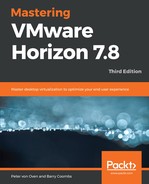In the next part of the process, we are going to install the Horizon View Agent onto the RDSH server. The agent is exactly the same agent as the one that you would install on virtual desktop machines and registers the RDSH with the Horizon Connection Server. To install the agent, perform the following steps:
- Open a remote console to the RDSH server running the applications, navigate to the shared software folder, and then find the agent installer, as shown in the following screenshot:

- Double-click to launch VMware-Horizon-Agent-x86_64-7.6.0-9539447. The seven-digit number at the end of the filename refers to the build version, and so you may have a different number, depending on the build version you are using.
- You will now see the Welcome to the Installation Wizard for VMware Horizon View Agent dialog box, as shown in the following screenshot:

- Click the Next > button to start the installation.
- You will now see the License Agreement dialog box, as shown in the following screenshot:

- Click the radio button for I accept the terms in the license agreement, and then click the Next > button to continue.
- You will now see the Network protocol configuration screen, as shown in the following screenshot:

- Click on IPv4 and then click on the Next > button to continue the installation.
- You will now see the Custom Setup screen, as shown in the following screenshot:

In the example lab, we are going to accept the default options; however, you can choose to install the 3D RDSH, USB Redirection, View Composer, and Flash Redirection options, should you want to.
As you can see, there are a number of features that can be installed as part of the View Agent installation. These are listed here:
- Core: Installs the core features required for RDSH
- 3D RDSH: Enables 3D acceleration in RDSH sessions
- USB Redirection: Redirects USB devices from the client to the RDSH session
- VMware Horizon View Composer Agent: Allows RDS host servers to be built from a single parent image using linked clone technology to easily deploy the RDS server farm
- Client Redirection: Allows clients to share local drives with the RDS sessions (not supported when using IPv6)
- Virtual Printing: Allows printing from RDS sessions
- vRealize Operations Desktop Agent: Allows the management agent to be deployed for monitoring RDS sessions with vRealize
- Flash Redirection: Enables the Flash redirection feature with RDS sessions (note that this is currently a tech preview in this version of Horizon View)
- Click the Next > button to continue the installation.
- You will now see the Register with Horizon 7 Connection Server configuration screen, where we will configure the Horizon Agent to talk to the Connection Server. This allows the Connection Server to read the published applications list from the RemoteApp catalog and allows you to create application pools within View.
- In the hostname or IP address box, enter the name of the Connection Server. In the example, this is hzn7-cs1.pvolab.com.
- In the Authentication section, click the radio button for Specify administrator credentials and then in the Username box, enter the user account you want to use to connect to the Connection Server. In the example lab, this is pvolabadministrator.
- In the Password box, type in the password for the account, as shown in the following screenshot:

- Click the Next > button to continue the installation.
- You will now see the Ready to Install the Program screen. Click the Install button to start the installation process.
- Once successfully installed, you will see the Installer Complete screen.
- Click Finish to quit the installation.
- You will then be prompted to reboot the server. Click Yes to reboot.
We have now completed the first part of the Horizon View configuration. In the next step of the process, we will turn our attention to the View Administrator and configure the application pools.
